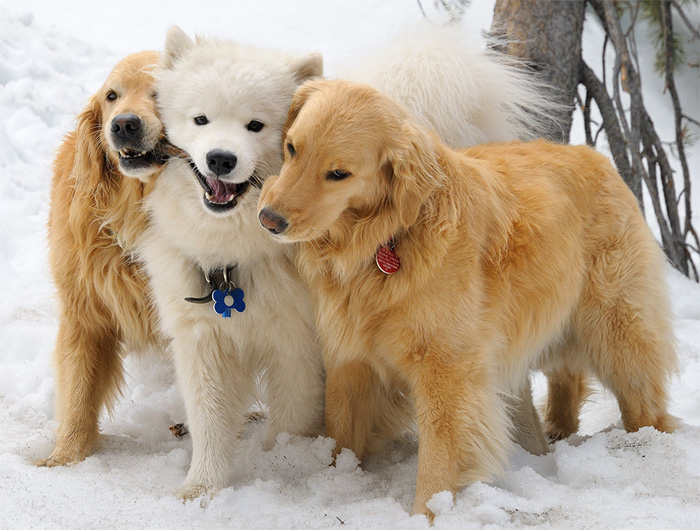Long-haired dogs require extra attention from their owners mainly because of their longer hair, which must be washed, brushed and combed more frequently than their shorter-haired counterparts. Indeed, interested individuals who want long-haired dogs as pets must carefully think about their decision to adopt. The greater investments in time, energy and effort, perhaps even in money for dog supplies, accessories and professional grooming sessions, should be carefully considered.
But when you make the decision to adopt a long-haired dog, you will find that the benefits outweigh the costs. For example, an Old English sheepdog has an attractive shaggy coat that may require more frequent grooming but when its keen intelligence, good attitude, and high trainability are considered, it is an excellent family pet.
Start with the following useful tips in the proper care of a long-haired dog and you will find the joys that come with being its owner.
Get the Right Tools and Supplies
Even before bringing home the long-haired puppy into your home, you should have the necessary grooming tools and supplies ready. You will be using the tools for several months, even years, so be sure to invest in durable products. You should also use vet-recommended grooming products, such as those sold by Petsmart and Petco, to ensure healthy skin and coat for your dog.
- Shampoo and conditioner especially-formulated for use on long-haired dogs particularly in controlling tangled and matted hair. The shampoo removes dirt, dust and grime and the conditioner helps in keeping the hair smooth.
- Brushes, combs and rakes for detangling and dematting the coat; removing dust, loose hairs, grass seeds, dead skin, and tangles from the coat; and assisting in shortening the coat moult during autumn and spring.
- Hair dryers for quick drying of the hair, which will also reduce the likelihood for matting and tangling while the fur is wet from a bath.
- Scissors are used in the removal of excess hair around the eyes and ears.
While you should ideally take your dog for professional grooming sessions at least once every three months, regular grooming at home will keep your pet’s hair, coat and skin healthy in between sessions.
Provide for Healthy Nutrition
Even frequent professional grooming will be of little use when your pet suffers from malnutrition including nutritional deficiency. You must provide your long-haired dog with the appropriate dog food to ensure its optimum physical and mental health particularly its lustrous and luscious coat.
Healthy fats in dog diet are crucial for healthy hair. With fat deficiency, your dog can develop coarse and dry hair as well as skin lesions with high risks for infections.
Fortunately, high-quality commercial dog food usually contains a well-balanced formula of all the nutrients including essential fatty acids (e.g., omega-6) crucial for a healthy coat and skin. While homemade dog food can also be provided to your pet, it may be improperly balanced so high-quality commercial dog food is still recommended for the main diet.
You can also add oil supplements, such as safflower or sunflower oil, into your pet’s diet. Just add one tablespoon vegetable oil per meal in case of a large dog or one teaspoon per meal for a small dog.
Keep Shedding Under Control
Long-haired dogs do not shed hair more than their short-haired counterparts although it may appear so; longer hair strands are easier to spot than shorter ones. Still, you will want to keep your pet’s shedding under control especially when you have a mild pet allergy.
- Brush your dog’s hair at least once a week, which will remove excess and loose hair.
- Groom your pet’s coat with a pin brush, which should reduce matted and tangled hair.
- Trim excess hair around the eyes lest it interferes with vision and increase the risks for infections.
- Remove excess hair around the paws and between the toes. Otherwise, your dog will have an uneven gait as well as suffer from an increased risk for infections brought on by the build-up of dirt, burrs, and salt crystals on the paws.
- Cut excess hair, too, under the armpits and backside. Feces can easily collect on the backside when it has untrimmed hair.
Manage Mats and Tangles with Baths
Dog care experts recommend a full bath for a long-haired dog once every three months although the frequency can vary depending on the dog’s breed, age and physical condition, among other factors. Just be sure not to give one too many baths; otherwise, the natural oils that protect the coat and give it its glossy shine can be stripped away.
Bathing a long-haired dog is similar to bathing a short-haired dog. You will likely spend more time on drying, brushing and combing because of the longer hair.
Long-haired dogs are a joy to have in your home. You just have to set realistic expectations about its proper care especially where its lustrous locks are concerned.


